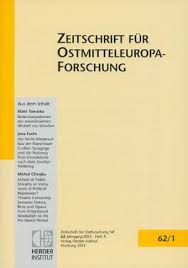Der Nicht-Wiederaufbau der Warschauer Großen Synagoge und die Nutzung ihres Grundstücks nach dem Zweiten Weltkrieg
The Not-Rebuilding of the Grand Synagogue in Warsaw and the Use of its Site after the Second World War
Author(s): Jana FuchsSubject(s): Architecture, Rural and urban sociology, WW II and following years (1940 - 1949), Post-War period (1950 - 1989)
Published by: Verlag Herder-Institut
Keywords: Not-Rebuilding; Grand Synagogue in Warsaw; Second World War;
Summary/Abstract: This article is an attempt to develop a new perspective on the decision-making processes and discourses in the rebuilding of Warsaw based on the discontinuities in construction on the property of the Great Synagogue before and after the Second World War. Instead of the Synagogue, which was destroyed in 1943 in the Warsaw Ghetto Uprising, the property was used to build what is today called the ‘azure skyscraper’. Beside to the reconstruction of the building process on the property based on the analysis of primary sources that have in part never been used before and on contemporary publications, the author discusses the question of to what extent the history of the property was reflected. The theoretical concept “space” and “place” as defined by Aleida Assmann is applied in this analytical process. This concept suggests that every geographical area can be seen as a “space” for future projects or as a “place” where something has happened – depending on the respective intention. The study examines the complex interaction of differing motivations from pragmatism, in partly ideologically-coloured urban management policy to politics of memory. All of the documented plans and discussions show that the property was primarily seen by the responsible individuals in the context of the redevelopment of the adjoining Plac Bankowy, which was enlarged after 1945 and the ideological importance of which was substantiated at the latest with the building of the Feliks Dzierżyński Monument in 1951. With the start of construction of an ambitious reinforced concrete skyscraper on the property at the beginning of the 1960s, the perspective of “space” emerged as predominant – even if the construction was not finished until 1991. In this process voices of different actors in 1946/47, in the late 1950s / early 1960s and since the 1980s have repeatedly argued to treat the property as a “place” bringing to mind its historical importance. This movement never gained enough momentum to result in politically effective demands for rebuilding the Great Synagogue.
Journal: Zeitschrift für Ostmitteleuropa-Forschung
- Issue Year: 62/2013
- Issue No: 1
- Page Range: 40-75
- Page Count: 36
- Language: German

